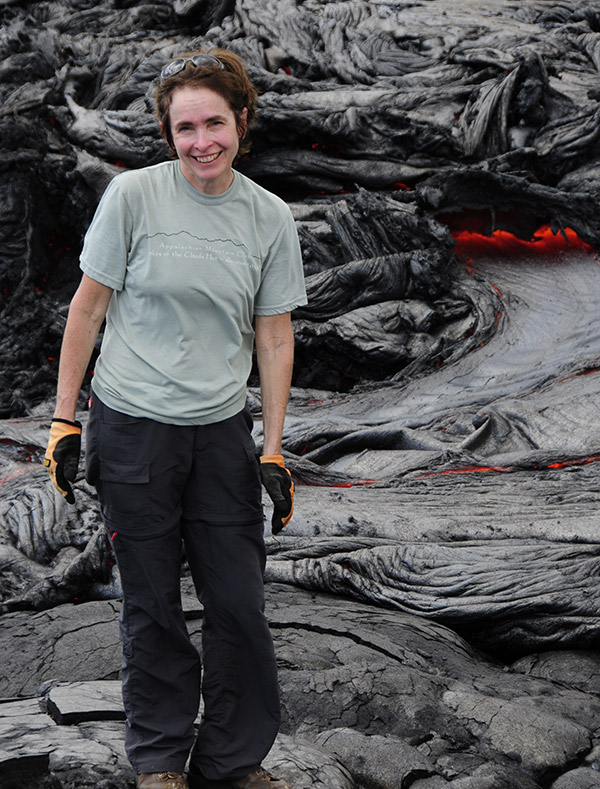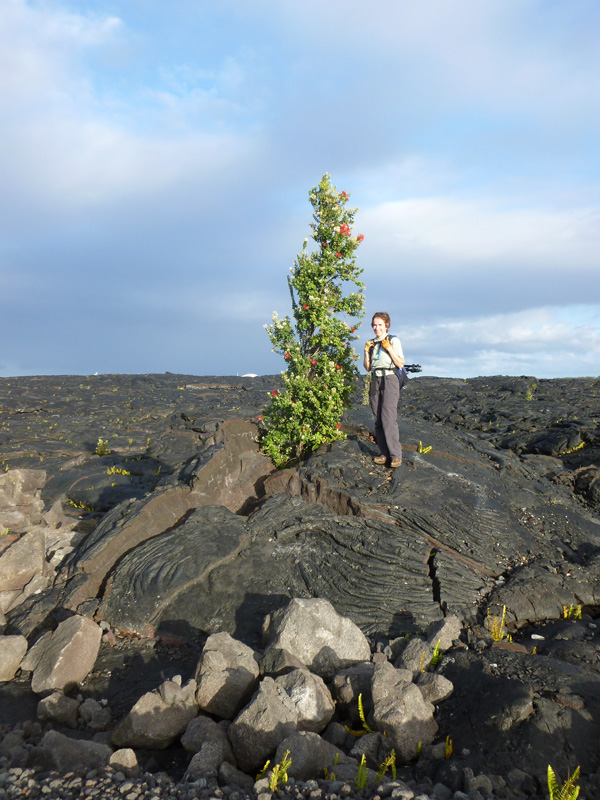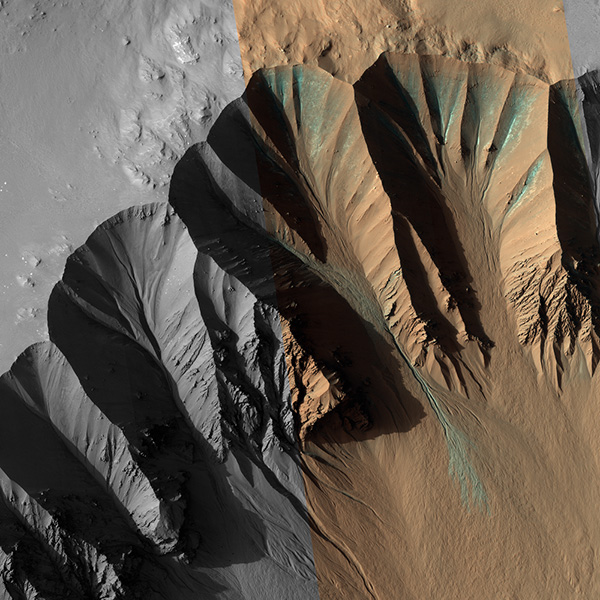5 June 2012
Volcanism & the thermal evolution of planets: An interview with Dr. Sue Smrekar
Posted by kramsayer

Sue Smrekar in front of a narrow lava channel in Hawaii, likely on its way to crusting over and becoming a lava tube. (Credit: Steve Anderson)
This post is the fourth of a series of profiles on planetary scientists by Mark Hilverda, geoscientist and web manager for AGU’s Planetary Sciences Section. A more complete version of this interview that includes a list of reading resources was published on the revamped Planetary Sciences website.
Dr. Sue Smrekar is the deputy project scientist for NASA’s Mars Reconnaissance Orbiter. At NASA’s Jet Propulsion Laboratory she helps coordinate the efforts of researchers working on the mission’s scientific investigations. Besides Mars, one of her principal topics of research has been the volcanism on Venus, based on data from NASA’s Magellan mission.
How did you first become interested in planetary science?
I was aware of the Apollo program at some level as a kid, and was, of course, fascinated. I started working my way through the “A’s” in interests: Astronaut, Astronomer, Anthropologist. But it wasn’t until I got to college that I was really exposed to planetary geoscience. I liked the outdoorsy, social atmosphere of the geology department. When I took a geodynamics class everything clicked for me – my love of math, physics, and the wonder of the natural world all came together in being able to write down equations that described how mountains formed and volcanoes erupted. Being able to apply those methods while exploring other planets was amazing.
Your research covers a broad range of topics from lava flows to the thermal evolution of planets. What attracted you to these subjects and a focus on the terrestrial planets?
I started studying Venus early on due to the new data from the Magellan mission in the 90s. I find the terrestrial planets very intriguing because I think they hold the most lessons for understanding how processes work on our own planet. Venus has remained my focus because I really view it as a laboratory for understanding how planets work. If we didn’t study the terrestrial planets, we really wouldn’t have as clear a picture of how processes like plate tectonics or mantle convection function. Other planets allow us to change variables like size, pressure, temperature, and volatile content and examine their effects on other worlds. I’m especially attached to volcanism because it provides a link between interior processes, surface geology, and atmospheric evolution. Oh, and the great field locations!

An example of a great field location: Sue Smrekar standing on tumulae near an Ohia tree in Hawaii. (Credit: Serina Diniega)
What are some your current research topics?
In terms of volcanism, one interest is in the emplacement of really enormous flows, the kind that can affect climate and surface geology in a big way. I’m studying both the morphologic features that can allow us to evaluate the history of flows on other planets, and the conditions that allow for tubes and channels to flow. Regarding Venus, I’ve been fortunate to collaborate with investigators on the European Venus Express Mission, especially Joern Helbert and Nils Mueller. Using data from the VIRTIS spectrometer, we’ve found evidence for geologically recent, relatively unweathered basalts. They all occur in my favorite geologic setting – hotspots! We had suspicions from Magellan data that they were areas of active mantle upwelling (known as hotspots), but these observations really seal the deal. Since this discovery, I’ve been modeling the convective processes that could produce the ~10 large mantle plumes we believe are active on Venus. It is probably no coincidence that Earth has roughly the same number of plumes. For Venus, which has a stagnant lid in contrast to Earth’s plate tectonics, we have hints that the mantle convective state that is producing a limited number of plumes may explain the apparent transition from plains volcanism to hotspot volcanism, as well the lack of a dynamo today. Additionally, the sites of recent or active volcanism could be the source of water vapor in the lower atmosphere.
You’ve been involved in different aspects of many planetary science missions including Magellan, Deep Space 2, and Mars Reconnaissance Orbiter (MRO), among others. What aspects of planetary missions do you find the most exciting?
Seeing the surface of a planet in an entirely new way is a huge rush. It feels like I imagine people must have felt when they came upon Victoria Falls or the Grand Canyon for the first time – really awed. Participating in the Magellan mission to Venus, and the MRO mission to Mars and seeing the first images is a profound experience. I think everyone I know who participated in a mission is hooked for life. Another thing I really love is working together with a group of people all focused on trying to understand a flood of data that reveals features and processes that have never been seen before. The synergy between people with different expertise and perspectives, world experts and inspired young students, is intellectually exhilarating.
Deep Space 2 was a unique mission that involved probes impacting into the surface of Mars. Although they reached Mars, no signals were ever received. There is often excitement and discovery with planetary science exploration, but sometimes also disappointment. Could you describe how science teams work through missions ending abruptly?
Ultimately we simply have to recognize that working in space is inherently risky, and failures pave the way for the next missions. But on the human side, I honestly I think we could do a better job of dealing with mission disasters. It is devastating to have something you’ve worked so hard on for years crash and burn (at least figuratively). When it became clear we weren’t going to be able to contact the probes, people just limped back home and tried to pick up the pieces of all their research projects. In hindsight, I wish I’d had a ‘wake’ to celebrate the accomplishments along the way and bonds we formed over the duration of the project to give a bit of closure.
Planetary science can yield results that challenge existing interpretation and understanding. A recent example may include the observations by the Venus Express orbiter which indicate an apparent rotation slowdown of Venus. What are some of your favorite unexpected planetary science discoveries?
In the past few years there have been numerous discoveries of both more recent volcanic or tectonic activity and more volatiles than previously recognized. This seems to be true throughout the solar system. On the Moon they are finding more interior water in the minerals and later faulting and volcanism than seen before. Mercury has also lots of volcanism and near-surface volatiles. On Mars, there is evidence of ground water alteration of minerals until relatively late in its history, and volcanism and Mars quakes within the last 10 million years. Plus we may finally have evidence for actual transient liquid water in the form of lineated slope streaks that only form in the Spring when the temperature is just right for melting of brines. Not to mention recent volcanism on, my favorite, Venus. The same is true for Titan and other outer solar system bodies. I love these discoveries because they challenge our understanding of planetary thermal evolution and the role of volatiles. In the big picture, heat and volatiles define habitability.

Recently formed gully on Mars. The green (false color) highlights the recent material. (Credit: NASA/JPL/University of Arizona. Image was compiled by Colin Dudas.)
MRO has been returning vast amounts of data and discoveries over the past 7 years. As spacecraft become more sophisticated the size of datasets continues to grow. How do you decide on which portions of data to focus your research efforts?
MRO is an incredible mission – we are coming up on 175 Tb of data. It is hard to choose, but my interest in thermal evolution drew me to studying the ancient crustal magnetization (another favorite discovery!) using gravity data from MRO. This work is led by a former UCLA student, Colleen Milbury. My postdoc, Serina Dinega, and I are using HiRISE data to study the volcanic features and how they have been emplaced. With my prior postdoc, Dan Nunes, we looked for subsurface ice with the SHARAD radar data. In particular we were looking for a source for the recent gullies that were initially thought to be due to fluid flow. We were unsuccessful, which is consistent with other studies that find dry landslides to be a more likely explanation for the gullies.
Do you have any recommendations and advice for those considering careers in planetary science?
Be diverse! One never knows what kind of mission or topic will be in vogue as leadership and priorities change, so it is definitely best to study a diverse range of planetary bodies and processes. Diversity includes studying the Earth! Our home planet will always be the basis for understanding other planets, so you should never stop studying the ground beneath your feet. Ideally, study areas that will make you desirable to mission science teams so you can get in on new discoveries. But at the same time keep your eye on big picture science objectives that will unify your research and give you a long-term direction.
What is your favorite planetary body and what data would you most like to obtain from further exploration?
I’m currently working on a mission proposal to send a geophysical package (seismometer, heat flow, and geodesy) to Mars. We want to both understand early planetary evolution processes, which are well preserved on Mars, and understand the thermal evolution, which controls volatile and habitability history. If we get selected, you can sign up to get a tweet every time there is a Marsquake! Yet Venus is still my first love! In my view Venus is key for understanding both geodynamics and climate. I would love to see high-resolution topography and radar imaging to unravel the geologic history, as well as emissivity for the entire planet to look for recent volcanism and low-silica, continent-like bodies. Noble gasses would tell us about the accretional and degassing history. Surface chemistry would help answer a suite of questions about interior and geologic processes. I would love to send a flotilla of missions. The discoveries coming out of the host of missions at Mars and the Moon have been terrific. I would be thrilled to see the same attention turned to Venus. I’m sure the discoveries would be dazzling and be a boon for understanding Earth as well.
– Mark Hilverda, geoscientist and web manager for AGU’s Planetary Sciences Section


 GeoSpace is a blog on Earth and space science, managed by AGU’s Public Information staff. The blog features posts by AGU writers and guest contributors on all sorts of relevant science topics, but with a focus on new research and geo and space sciences-related stories that are currently in the news.
GeoSpace is a blog on Earth and space science, managed by AGU’s Public Information staff. The blog features posts by AGU writers and guest contributors on all sorts of relevant science topics, but with a focus on new research and geo and space sciences-related stories that are currently in the news.
That is awesome…I love those pics!